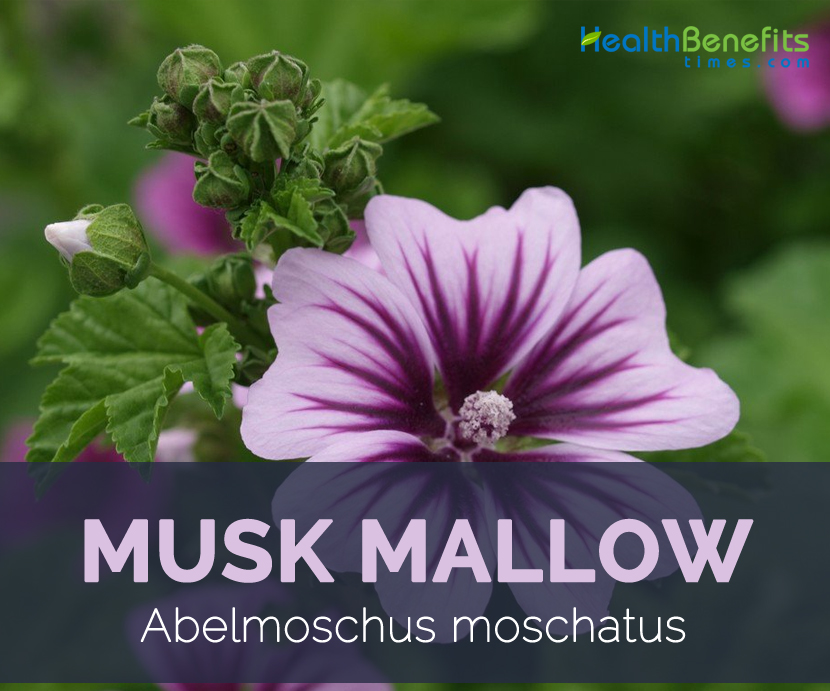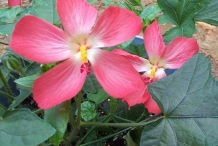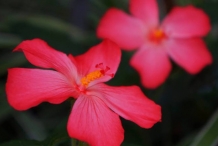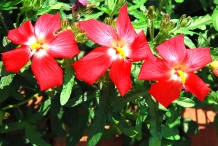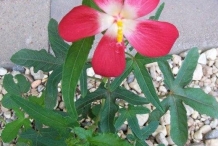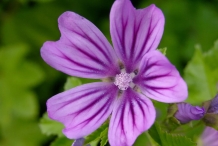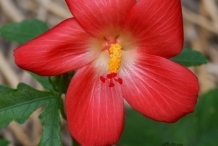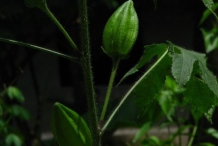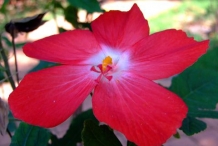Plant
Abelmoschus moschatus is a soft, herbaceous trailing plant, 0.5- 2.5 meters high with soft hairy stems and a long slender tap root. Leaves are polymorphous, ovate-cordate or more usually palmately cut into 3-5 acute lobes, dentate-serrate, hairy on both sides. Petiole is usually longer than leaves, with long deflexed hairs. Stipules are small and subulate. Flowers are solitary, axillary, large, 3-4 inch, bright yellow, with a purple center. Pedicels are stout, curved, much thickened beneath the flower. Epicalyx segments are 6 – 10, fulvous-hairy. Calyx is spathaceous, deciduous. Corolla is yellow with purple center. Stamens are monadelphous. The flowers are hermaphrodite (have both male and female organs) and are pollinated by Insects.
Fruit
Fruit is long, lanceolate in form of capsule with numerous greyish-brown-blackish seeds, kidney-shaped, slightly compressed with shallow depressions on both sides. They are not velvety to touch. They smell musk-like but with no taste.
Health benefits of Musk mallow
Abelmoschus Moschatus (Ambrette) is a nutritious and healthy wild vegetable. It can lower cholesterol and prevents atherosclerosis. Listed below are some of the popular health benefits of Musk Mallow:
1. Constipation
The fiber content in seedpods and mucilage substance in Abelmoschus Moschatus helps reducing habit of constipation. It lubricates the gut and eases in passing stools. Ambrette is beneficial in constipation with dry and hard stools.
2. Dysuria (painful urination), Cystitis, Urethritis & Gonorrheal Cystitis
Ambrette seeds are used for their diuretic action in urinary diseases. Seeds also have anti-inflammatory and antimicrobial properties due to which they help in reducing inflammation and infection of urinary tract and urinary bladder.
3. Diabetes
Indian folks use Musk mallow (Kastori Bhindi) in diabetes. Ambrette seeds are more beneficial for stabilizing sugar level in the blood.
Traditional uses and benefits of Musk Mallow
- It cleanses urinary bladder, acts as aphrodisiac and is useful in eye disorders.
- Roots and leaves help to cure gonorrhea.
- Seeds are also chewed as a nervine, stomachic and to sweeten the breath.
- Seeds are valued medicinally for their diuretic, demulcent and stomachic properties.
- They are also said to be stimulant, antiseptic, cooling, tonic, carminative and aphrodisiac.
- Paste of the bark is applied to cuts, wounds and sprains.
- Essential oil is used in aromatherapy for the treatment of depression and anxiety.
- It is also applied externally to treat cramp, poor circulation and aching joints.
- Decoction of seeds is given internally for disorders of the spleen, vomiting and pectoral lesions.
- Musk Seed Oil is used in aromatherapy for anxiety, depression, nervousness and stress.
- Leaves and roots are used for headaches, rheumatism, varicose veins, fever and gonorrhea.
- Plant is considered a heart tonic and an excellent snakebite remedy.
Culinary uses
- Muskdana seeds are added to coffee for flavoring.
- Its leaves are used as vegetable.
- Young leaves and shoots are cooked in soups.
- Leaves are also used to clarify sugar.
- Seed is fried or roasted and has a flavor similar to sesame seeds.
- Seed is also used as a flavoring for liqueurs or to scent coffee.
- An essential oil is obtained from the plant and is used to flavor baked goods, ice cream, sweets and soft drinks.
Other Facts
- Ambrette oil is extracted from seed, is used in perfume industry.
- It is used as a food flavoring and in perfumery as a musk substitute.
- Seeds are used as an insecticide.
- Mucilage obtained from the roots is used as a size for paper.
- Tobacco is flavored with the flowers.
- Harvested seeds are sun dried and use in perfumery industries.
- Cream, yellow and green dyes can be obtained from the plant and the seed heads.
- Fiber obtained from the stems is used for cordage, textiles and paper making.
- Bark yields a fiber that is used to produce tough cloths.
Ayurvedic health Benefits
- Cramps, intestinal disorders, loss of appetite: The tea or tincture prepared from the seeds is taken orally to heal cramping.
- Excess phlegm: Fruits are eaten to reduce the phlegm.
- General tonic: The juice obtained from the fruits is used as general tonic.
- Gonorrhea: The mucilage prepared from the roots and leaves is given orally.
- Itch: The seeds are rubbed to a paste with milk, and applied.
- Nervous debility, spermatorrhoea (Dhatu Roga), urinary disorders, Prameha, flatulence: Soak the chopped fruits in water at night and drink the water and chew the pieces next morning.
- Oral problems: Prepare decoction of seeds/leaves and use as gargle.
- Sweeten the breath: Chew the seeds.
- Urinary problems: Seed powder dissolved in water is given with Honey at night after meal.
- Worms, gastro-intestinal disorders: Extract of seeds in given.
Musk Mallow Facts
Abelmoschus moschatus also known as Ambrette seeds, Annual hibiscus, Musk mallow, Musk seeds, Ornamental okra is an aromatic and medicinal plant native to India. The ambrette seeds have a sweet, flowery, heavy fragrance similar to that of musk. Abelmoschus manihot is used to make neri, a starchy substance used in making Washi. It is a non-toxic plant with edible leaves, flowers and seeds. The flowers and seeds can be eaten raw. Every part of this medicinal plant is used in one or the other way. Musk mallow drives its name due to the musk like fragrance of its flower.
| Musk mallow Quick Facts | |
|---|---|
| Name: | Musk mallow |
| Scientific Name: | Abelmoschus moschatus |
| Origin | Tropical Asia |
| Shapes | Long, lanceolate in form of capsule |
| Taste | No Taste |
| Health benefits | Diabetes, Constipation, Dysuria |
| Name | Musk mallow |
|---|---|
| Scientific Name | Abelmoschus moschatus |
| Native | Tropical Asia |
| Name in Other Languages | English: Ambrette plant, Fautia, gandapura, Kasturi, Musk, musk mallow, Musk mellow, musk okra, musk seed, Muskmallow, Muskseed, okra, rose of Sharon, Vegetable musk plant, tropical jewel-hibiscus Arabic: Abu-el-misk, abu-l-mosk, habb el mosk, Hab-Ul-Mishk Assamese: Gorokhiakarai. Chamorro: Kamang, caamung Chinese: Shān yóu má (山油麻), Fúróng má ( 芙蓉麻), Yě miánhuā (野棉花), Yě yóu má( 野油麻), Huáng kuí (黄葵) Fijian: Ambretta semi, Aukiki, O’e’e, Okeoke, Vakeke, Wakeke, Wakewake, Wakiwaki French: Algalia, Almizcle vegetal, Ambrette, gombo musqué, graine de musc, ketmie des marais, ketmie musquée, mauve musquée German: Ambramalve, Bisameibisch, Muskateller-Bisameibisch, Muskateller-Eibisch, Moschus-Malve Indonesian: Gandapura, kasturi Italian: Ambretta, Abelmosco, Fior muschiato, Ibisco muschiato. Gujrati: Bhindo, Bhinda Punjabi: Mushak Dana, Lata Kasturi Hindi: Mushk dana, मसक दाना, Jangli bhenda, Latākastūri, Kannada: Kaadukasthuri, Kasthuribende, Kasturi Kande, Kadu Kastuar, Kasthoori bende Malayalam: Kasthurivenda, Kattukasthuri, Lathakasthuri, Kasturi Kanda, Kapas hantu, Kapas hutan, Marathi: Van Bhendi (वन भेंडी), kastur Bhendi (कस्तूर भेंडी), Kasturi-Bhenda Samoan: Aute toga, Fau tagaloa Swedish: Myskmalva Sanskrit: Latakasturika, Latakasturi, Kattaphala, Katuka, Gandhapura, Kasturilatika Siddha: Kattu Kasturi Telugu: Kastur benda, Kasturi Bendavittulu, Karpura-Benda Tamil: Vettilaikkasturi, Kattuk-Kasturi, Kasturivendai, Kattukkasturi, Veṟṟilaikkastūri. Farsi: Mushk Dana Bengali: Kasture, Kala-Kasturi, Latakasturi, Mushakdana. Austral: fautia Chuukese: karereon, karereon nikapwerik nik, kareron, likonokon, niikapwériik, niikownown, nikapwerik, nikokon, setmwechin, sotumo Deccan: Kasturu- Benda Japanese: Ryûkyû tororo aoi Mangarevan: Pukawa Maori (Cook Islands): ‘Aute, ta‘uri‘au, vavai tara, vavai tara, vavai tara, vavai tara Niuean: Fou hele, fou ingo Palauan: Gongul Pohnpeian: Kaanth, matai, metei, metey, methey, tehmetei Samoan: ‘Aute toga, ‘aute toga, fau mageso, fau samasama, fau Tagaloa, fau tagaloa, fau Tagaloa, vavae Samoa Persian: Mushk danah. Russian: Абельмош мускатный Abelʹmosh muskatnyj, Гибискус мускусный Gibiskus muskusnyj, Желтый гибискус Zheltyĭ gibiskus. Solomon Pijin: Te vasivasiakarai Sundanese: Kakapasan. Tagalog: Dalupang, kastiokastiokan, kastuli Tahitian: Fautia, foutheea, pukawa Thai: Chamot Ton, Mahakadaeng,Som Chaba Vietnamese: Cay Bong Vang, Bup Vang) Tongan: Fau‘ingo, loa Turkish: Anber çiç. Vietnamese: Cây bông vàng, Bụp vang, Bụp vàng, Búp vàng, Vông vang, Vông vàng. Ulithian: Hathongethong Unani: Musk-Daanaa, Habb-Ul-Mushk Wallisian: Fau ingo Yapese: Kamwayang Singhalese: Kapu Kimissa, Kapukinissa |
| Plant Growth Habit | Soft, herbaceous trailing plant |
| Growing Climate | Wastelands, slopes, valleys, stream sides, flat areas, often cultivated for commercial use |
| Soil | Moist, moderately fertile, well-drained soils |
| Plant Size | 0.5- 2.5 meters high |
| Root | Long slender tap root. |
| Stem | Hairy stem |
| Leaf | Polymorphous, ovate-cordate or more usually palmately cut into 3-5 acute lobes, dentate-serrate, hairy on both sides. Petiole is usually longer than leaves, with long deflexed hairs. Stipules are small and subulate. |
| Flower | Solitary, axillary, large, 3-4 inch, bright yellow, with a purple center. Pedicels are stout, curved, much thickened beneath the flower. |
| Fruit Shape & Size | long, lanceolate in form of capsule |
| Flavor/Aroma | Musk-scented |
| Taste | No Taste |
| Seed | Greyish-brown-blackish, kidney-shaped, slightly compressed with shallow depressions on both sides. They are not velvety to touch. |
| Plant Parts Used | Seeds, root and leaves |
| Health Benefits |
|
| Traditional Medicinal Uses |
|
| Precautions |
|
References:
http://eol.org/pages/584456/communities
http://easyayurveda.com/2015/05/24/latakasturi-abelmoschus-moschatus/
http://www.hear.org/pier/species/abelmoschus_moschatus.htm
http://davesgarden.com/guides/pf/showimage/395735/
https://npgsweb.ars-grin.gov/gringlobal/taxonomydetail.aspx?id=104912
http://pfaf.org/User/Plant.aspx?LatinName=Abelmoschus+moschatus
http://www.gbif.org/species/3152709/vernaculars
http://www.missouribotanicalgarden.org/PlantFinder/PlantFinderDetails.aspx?kempercode=a556
https://en.wikipedia.org/wiki/Abelmoschus_moschatus
https://www.bimbima.com/herbs/latakasturi-musk-mallow-information-medicinal-uses-and-more/1929/
http://veggiesinfo.com/musk-mallow/
http://www.plantnames.unimelb.edu.au/Sorting/Abelmoschus.html
https://www.itis.gov/servlet/SingleRpt/SingleRpt?search_topic=TSN&search_value=21772#null
http://www.diethealthclub.com/health-food/muskmallow-health-benefits.html
https://www.drugs.com/npp/ambrette.html
Comments
comments
